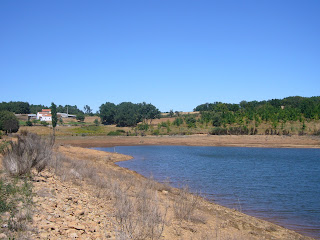After my quick tour of Almeida, I hit the road for Sabugal. I had read a detailed account of this action in Mark Urban's splendid book "Rifles", and the location was just off my route southwest to Coimbra and the battlefield of Bussaco.
Sabugal is a quaint little town in a bend of the River Coa,
with an old Moorish castle, and small baroque citadel, surrounded by wooded
hills. All very nice, but a sign or some
directions indicating where the battle was? - none! I drove around for about 40
minutes trying to work out the location of the battle from an old map, but no
luck. Eventually a quick stop in a café/bookshop/museum by the castle got
results.
The shop was partly dedicated to (and possibly run by) the local Jewish community who had survived
hidden with false identities for hundreds of years, praying in secret whilst outwardly pretending to be Christian. Anyway, the people I met were extremely friendly and helpful; real ambassadors for their town and region.
On a shelf in the shop was
a small display of buttons and musket balls, and one cannon ball. When I asked
the owner where she got the cannonball, she replied that she had found it herself, and
more importantly at the site of the battle, and that she had arranged two years before for a small commemoration memorial
to be built there. So instructions in hand I made my way
out to the battlefield.
To get there, you have to drive out the main road Southeast from Sabugal to Quadrazais. When
you reach the outskirts of Sabugal you will see a sign on the right pointing to Teixedas; take this turn.
The
road is basically a metalled track, so if the road looks dodgy, then you know
you are going in the right direction. Follow the track for about 1.5 km past a
few houses and farmhouses and then through a small forest.
The memorial to the
battle field should be at a small T junction, just as you come out of a copse
of trees. In the background you should see a large resevoir, which is a dammed
section of the Coa (and where the Light Division crossed and ascended the hill
to meet the French).
The battlefield doesn’t seem to have changed that much,
though as mentioned, the river Coa is now a dammed lake in this part, so it’s
hard to tell what the original crossing point would have looked like (obviously
a lot lower down than the current water’s edge). The land is partly farmed and
partly forested, though I am not certain of much forestation there was in 1811
(for example, the hill at Bussaco, which is heavily wooded now, was completely
bare of trees at the time of the battle).
Looking across the line of the French position.
Looking from the French lines down towatds the River Coa. This was the ground the Light Division had to cover during their attack (or as they blundered into the French during the early morning fog).
I drove down to where the Coa would have flowed, and you can
see that it is a long open climb up to where the French positions would have
been. If open at the time this would have been a long bloody walk.
Looking up to the memorial from near the river.
As it is, the
hill is deceptively steep. If the French had been fully deployed when the Light
division encountered them, then Beckwith's Brigade of the Light
division would have been in trouble (though such an engagement/sacrifice may have enabled
the main British Force to bag the Reynier's men). As it was, beckwith's Brigade found itself hanging on against odds of 5 to 1. Only the eventual crossing of the Coa of the Drummonds Brigade, and emerging on the right of Beckwith held the day, in addition to reynier catching sight of Wellington's main force making its way through
Sabugal, and wisely ordering a general retreat before he was trapped.
The Coa today in this part is now dammed, creating a partly flooded valley. The original ford is probably somewhere in the mid-distance in this photograph.
Apart from the higher level of the River Coa, the land is largely unchanged. There is nothing in the way of any interpretaion of the battle at the site apart from a small brass plaque. Still it is worth a visit and is an easy day trip from Ciudad Rodrigo.























Great pics! And very nice to meet up with you at Salute.
ReplyDeleteHi Ray, thanks, and great to meet up with you as well. Good to finally put a normal face to your blog :-)
DeleteA pleasure to meet you and apologies for not visiting more.
ReplyDeleteHello Fran. Likewise it was a great pleasure to meet you, and also with the rest of the Posties Rejects and bloggers. A good talk all round I'd say. Now I'd better start working on next year's bonus so that I can get to Salute 2014 :-)
Delete